Cutting down trees in your yard allows new trees to grow and improves lighting for other plants. However, uprooting a tree from your property can be difficult and expensive, and it’s especially irritating when you’re left with a stubborn stump. Read on for our kill tree stump for good guide.
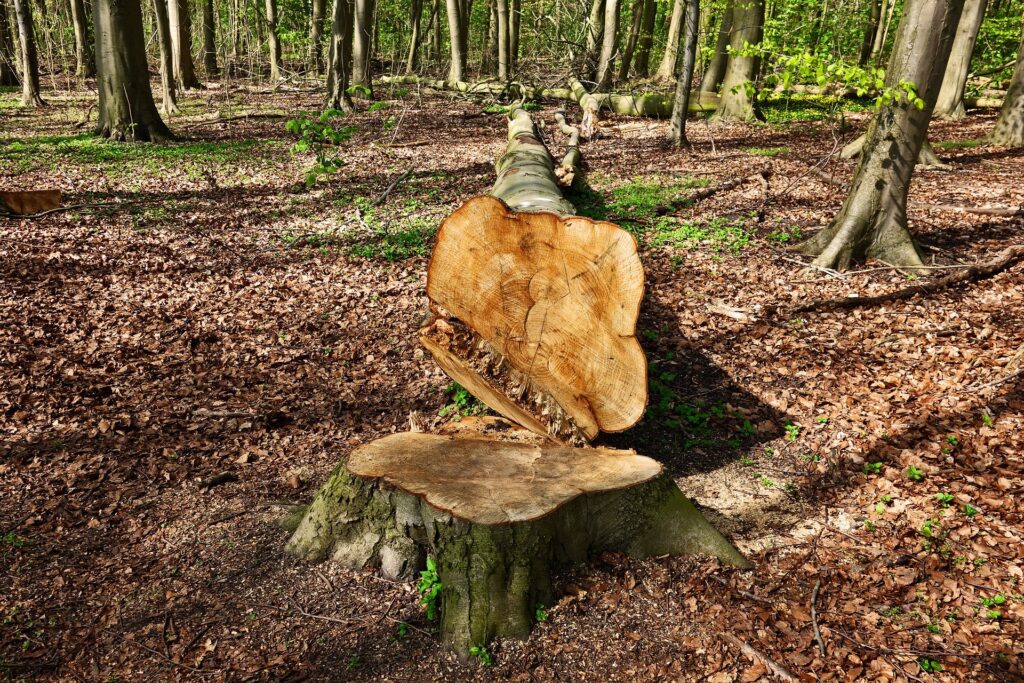
If you’ve ever had a tree removed from your yard, you know how annoying the stump can be. Luckily, however, there are many ways that can help you get rid of that pesky tree stump in your yard once and for all.
Tree stumps are a tripping hazard, an eyesore, and can attract insects, fungi, and germs to your garden.
RELATED: How To Get Rid Of Fungus In Mulch For Good | The Ultimate Guide
You could let the tree stump decay and decompose naturally, but that could take years, or it could start to grow again. Therefore, if you have a tree stump in your yard that is sprouting new shoots, you need to eliminate it as soon as possible, or it may continue to expand.
Also, if you don’t remove a tree stump, you’ll have a trip hazard in your yard, and it will even attract pests like fungi and insects to your yard.
Fortunately, you can get rid of the tree stump on your property in several ways, some of which involve the use of chemicals (like Roundup Tree Stump & Root Killer), natural removal methods (such as Epsom salt, boiling water, or rock salt), and use of manual removal methods (such as digging, burning and grinding).
Continue reading to find a solution that is suited to your situation and fits your needs.
Physical Methods To Get Rid Of A Tree Stump
If you’re willing to put in the time and effort, the following are some physical methods for getting rid of your tree stump.
However, there are some obvious limitations associated with the use of physical removal methods. For instance, when compared to natural and chemical processes, they require a bit more effort and resources to carry out, despite the fact that these procedures are significantly faster and more straightforward.
1. Grind The Tree Stump Down
A “stump grinder” is a machine that is used to grind down tree stumps by ripping out the roots and shattering the timber.
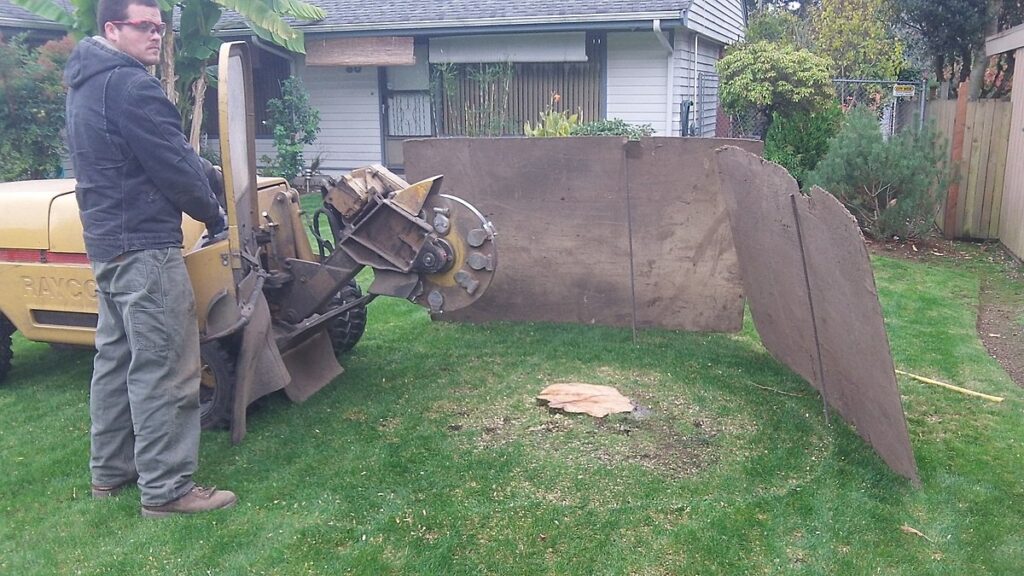
This is the quickest way to remove tree stumps and kill any remaining tree roots. However, it requires either employing the services of a professional tree remover or renting a stump grinder machine in order to dismantle the tree’s trunk and remove the roots.
Using this method, the stump can be ground down and removed in as little as fifteen minutes, but the process could sometimes take as much as two hours.
So, if you are pressed for time, you can eliminate a tree stump by reducing it to sawdust with a grinder. Although it can be a bit filthy and noisy, this grinding thing is, without a doubt, the most effective approach to getting rid of a tree stump in a hurry.
Cost Of Grinding A Tree Stump
In the United States, you may rent a grinder for anywhere between one hundred and two hundred dollars per day. In contrast, the price in the United Kingdom is one hundred and twenty pounds per day. Also, you will have to pay extra for labor in both regions.
Plan Ahead
You also don’t want to drag this massive piece of equipment across your front path only to discover that you can’t fit it through the garden gate to get to the area where the tree stump is located. Therefore, make sure that you plan ahead and that you can carry the stump grinder from the curbside delivery location to the location of the tree stump.
Safety Is A Must
When operating a powerful machine like a stump grinder, it’s crucial to take precautions and follow all safety protocols. This includes wearing protective gear like earplugs, steel-toed boots, and goggles and paying close attention to the manual’s directions.
The use of a stump grinder exposes the user to many risks, including the potential for severing utility wires and flying wood chips or boulders. So, both the person doing the grinding and the bystanders can put themselves in harm’s way during the procedure.
How To Use A Stump Grinder?
Use the Call Before You Dig hotline, which can be reached at 8-1-1 at least two weeks before the day you intend to start working. You will be provided with a map that marks the positions of all subterranean gas, electric, water, and communication lines. Nevertheless, here is how to use a stump grinder to get rid of a tree stump on your property:
- Cut the stump down to within a few inches of the ground with a chainsaw.
- Remove any rocks or other objects from near the trunk that could be thrown about and around by the grinder’s operation.
- The next step is to place the stump grinder just over the stump while wearing protective eyewear and a face mask.
- Slowly bring the grinder down across the trunk, lowering it on each side as you go.
- Grind the trunk with the grinder until the place is about 3 inches below the ground.
- Lastly, take out the wood chips, throw them away, and backfill the hole with soil.
2. Burn The Tree Stump
If you don’t live in a fire-prone area, you can get rid of that tree stump by lighting it on fire with some kerosene.
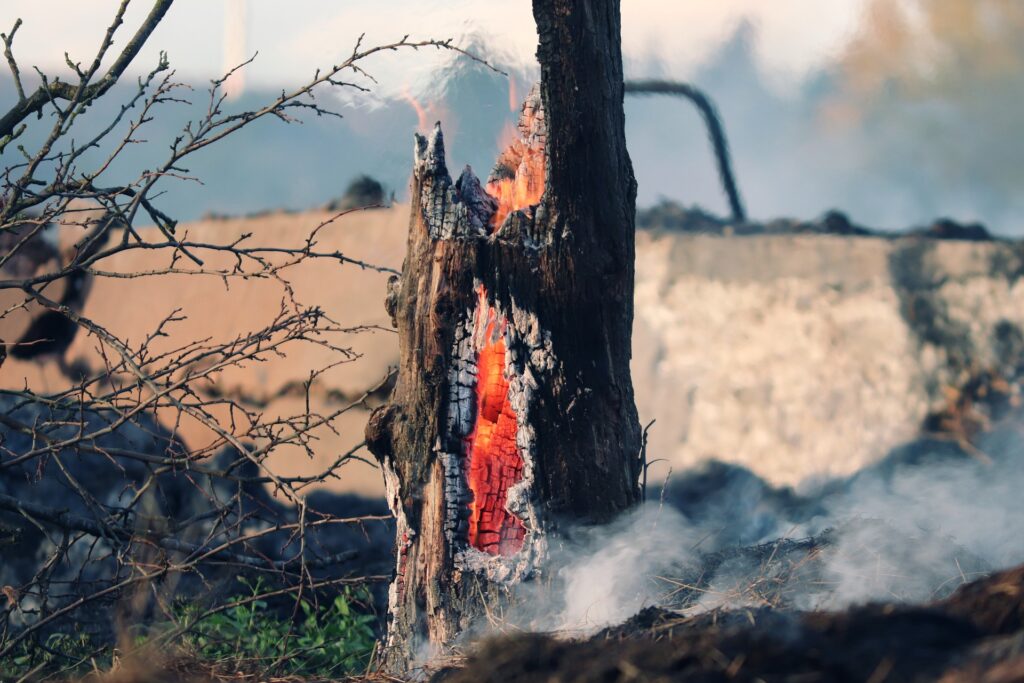
If the stump has been dried out completely, then burning it could be a viable solution to the problem. This technique may need more time than grinding and may not completely eliminate the roots that grow below the soil’s surface.
Still, it could produce satisfactory results with considerably less effort on the user’s part. Furthermore, using this method can be risky, and in certain regions, it is unlawful to do so due to fire rules.
Make Sure There Are No Restrictions
So, if you want to burn your tree stump, you should first find out what the restrictions are in your area and then determine whether or not it is safe to burn it.
This will not be the best strategy for you to use if you have a lot of plants nearby. Also, before you light the fire, make sure the area is clear of anything that could catch fire.
Extinguish any flames as fast as possible by bringing a garden hose that is connected and pressurized to the area.
Burning the stump may take a day or perhaps longer, depending on the type of wood, weather conditions, the size of the stump, its moisture content, and the myriad of other factors that come into play.
Burning Tree Stump Is Not Easy
However, tree stumps do not catch fire as quickly as you might think they would, so you will need to prepare them before attempting to ignite them on fire. So, before you start lighting matches to burn the stump, you should first pick which method you will use.
But You Can Do It!
There are various alternative approaches you can take. For instance, you could use a chainsaw to cut crisscross lines in the wood that are approximately five to six inches deep and then just ignite some kindling on top of those lines to start a fire.
You also have the option of drilling holes into the trunk, filling each hole with kerosene, and allowing it to burn. More information on these two approaches can be found as follows:
Drill & Burn
To begin, drill a number of holes evenly distributed around the surface of the stump.
The holes should have a width of approximately half an inch to one inch (1.3 to 2.5 cm) and a depth of at least eight inches (20.3 cm) or twelve inches (30.5 cm) if you have a drill bit that is sufficiently long. This not only improves your chances of getting the fire started but also enables an excellent airflow that can fuel the fire.
The next step is to saturate the stump with kerosene, making it easier for you to set fire to it and reduce it to ash. Soaking the stump thoroughly is a must; otherwise, the fire may burn out before it has a chance to spread to the root tips.
You might also soak strips of rag or fabric in a flammable liquid like BBQ lighter, white spirit, or something similar. Then press the cloth through the drill holes so that it is embedded deeply through the tree trunk. Next, place discarded pieces of wood atop the stump, and then use a fire starter to light the wood on fire.
As the fire dies down, the stump will catch on fire and be consumed by the flames.
Saw & Burn
In this method, using a chainsaw or pole saw, a grid is cut into the top of the tree stump before it is set ablaze as part of the saw and burn procedure. So, make vertical cuts into the wood to form a grid of uprights that are 2 inches by 2 inches.
This offers a terrific approach to get the fire to go deep down into the tree stump in order to accomplish the task in a very timely and efficient manner. The burning procedure we recommend is much the same as for all these methods.
Pro Tip: Moving soil away from the root of the stump will enhance airflow and allow the process to move forward more quickly. Since fire can only thrive in the presence of oxygen, the more air it can get, the quicker it will burn.
Keep in mind as well that, in contrast to the ways that involve grinding the stump away, this method will only remove the stump down to the level of the earth’s base. Therefore, it will not eradicate the roots close by or remove the stump entirely.
RELATED: What Is Digging Holes In Your Lawn? Causes and Solutions
3. Dig The Tree Stump Out
Digging out a tree stump is effective but time-consuming and might damage your yard or garden.
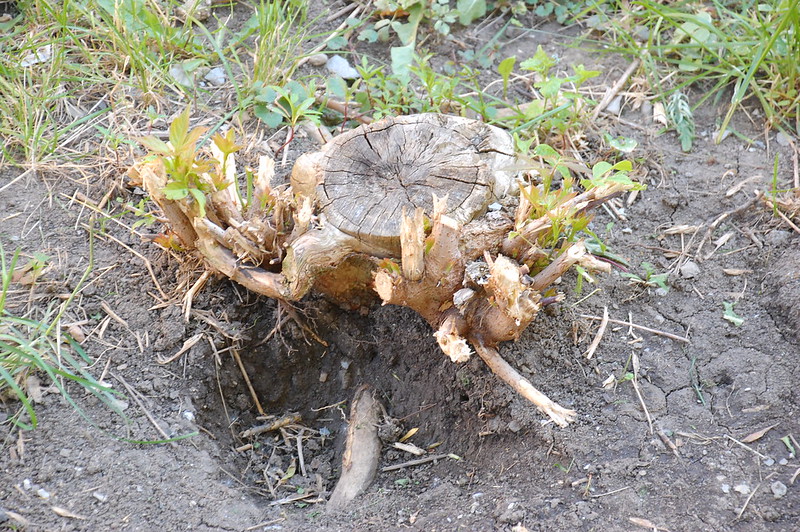
Using this procedure, you will be able to get rid of as many tree roots as possible while also ensuring that the stump will not continue to develop.
Also, consider hiring a professional who is equipped with excavating equipment to complete the task so that you can save time and effort. This method is slow and time-taking. However, if the stump is less than around 12 inches in diameter, digging it out might be the most feasible alternative.
Digging merely calls for using fundamental hand tools instead of renting or hiring an expensive and cumbersome machine. Once again, however, this method requires a lot of manual labor, but it is not impossible if you have the appropriate tools.
To remove a tree stump, begin digging around the stump and try to uncover as many of its roots as you can. Then, cut the big roots using a hatchet, handsaw, or chainsaw, depending on their size. Loafers or clippers can be in use to trim away more manageable roots.
You should be able to pull the tree stump out of the ground once all of the roots have been dealt with. After that, fix your yard by backfilling the large hole with dirt and then covering it with either mulch or topsoil. Detailed instructions on how to do it are provided below:
Guide:
- Dig around the base of the stump to uncover as many of its roots as you can.
- To remove the bigger roots, you can either use a jigsaw, an ax, or a chisel. As you continue to dig, you can uncover tiny roots that can be severed with cutters or pliers.
- After you have severed all of the roots that are surrounding the stump, you can then raise it up and take it out of the ground.
- Lastly, fill the opening with dirt and then cover it with either mulch or topsoil.
How To Kill A Tree Stump Naturally?
The elimination of a tree stump calls for patience. You can kill tree stumps on your own without having to pay a professional, but the methods that you use could be time-consuming.
However, if you are patient, the natural decay processes will eventually take over and weaken the wood, making it possible to remove the tree sump from your property more quickly. So, here are some different methods that you can use to remove a stump yourself.
Consider making use of one of these simple, low-cost, and easy-to-find home treatments to destroy a tree stump utilizing items that you may already have on hand:
1. Use Boiling Water To Kill A Tree Stump
The tree will die if you dig a pit around it and dump boiling water on it for hours or days.

Boiling water can cause severe damage and even death to the root system of a tree stump. However, this method is fantastic because it can be complete in a reasonable amount of time and does not require a lot of money.
Also, by using the following method, you can eliminate a tree stump without resorting to herbicides or other tree stump killers. Nevertheless, the following is a guide on how to use boiling water to kill a tree stump.
- Uncover the root structure that is contained within the ground near the tree stump.
- The tree stump should then have holes drilled into it at both the roots and the top in order to allow the hot water to reach it.
- After you have completed the drilling, slowly pour boiling water into the holes of the stump and roots, ensuring that the water covers the entire stump.
- The shock of the boiling hot water to the tree stump and its root system will ultimately result in the tree’s death as it will cause severe damage.
- After the roots and stump have died, the process of natural decomposition can start.
2. Kill The Tree Stump By Forces Darkness
Imposing darkness on a tree stump is likely the most straightforward approach for putting an end to it.
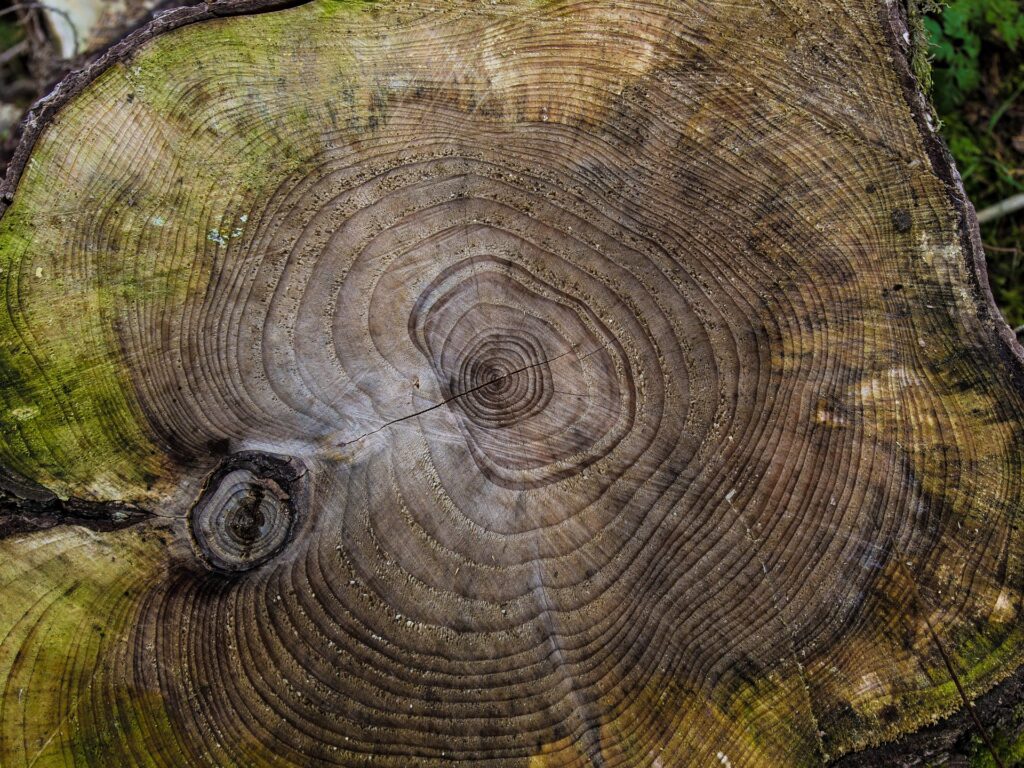
Try this method if you want to get rid of the stump in a way that is all-natural and doesn’t involve any chemicals. Trees and the shoots that sprout from their stumps need light to make food, so why not turn the lights off?
The forced darkness method is simple and cheap. Therefore it’s our top recommendation if you need to get rid of a tree stump easily.
Also, the process of the tree stump’s decomposition will speed up significantly if it is not exposed to sunshine. It should take two to three months for the food to rot. Nevertheless, detailed instructions on how to do it are as follows:
Guide:
- Like the methods mentioned above, chop the stump off as close to the roots as possible by using a chainsaw, a hatchet, or a handsaw.
- The tarp should then be used to cover the stump as much as possible.
- Make use of a cover that is resistant to light, such as an opaque trash bag, a dark plastic bag, or a tarp. In addition to this, the cover you select ought to be constructed out of a material that is waterproof.
- Put some hefty pebbles or bricks onto the tarp to weigh it down. In order to hide a smaller stump, you can use a box or bucket of a similar dark color.
- Last but not least, create a pile of organic garbage over the tarp that is at least one foot deep. Also, cover the nearby roots as well.
- You can use a stump removal treatment to hasten the process while it is happening. It can be purchased at nurseries and garden centers nearby.
- Suckers might sprout from the exposed part of the root zone with the passage of time, but the stump itself will gradually deteriorate and eventually die.
3. Use Rock Salt To Kill A Tree Stump
Rock salt, another multi-use substance, can help remove stumps, but use caution.

Rock salt is a simple and inexpensive method that can be in use to kill a stump. However, it can take many months for the stump to die when you use the salt approach, so if you must get rid of the stump as quickly as possible, this option might not be the best one for you.
The difference between rock salt and table salt is that rock salt is significantly less refined and typically comes in huge chunks. However, conventional table salt should not be in use because it is detrimental to the soil in the area around the stump.
Use rock salt that is pure and contains no other additives. In addition, remember that rock salt is composition of the elements sodium and chlorine.
These elements may damage some desirable plants.
Additionally, sodium and chlorine replace essential nutrients for plants, such as phosphorus and potassium, leading to deficiencies and, ultimately, plant death. Nevertheless, if you want to finish a stump with the help of rock salt, here is how to do it:
Guide:
- Drill holes all over the top of the stump so that the solution can work its way inside.
- Also, when you are dealing with a stump that has large aerial roots, it is very necessary that you also drill holes in those roots as well.
- The rock salt should be used to fill the holes and cover the stump entirely. Remember to fill in the holes that you made into the aerial roots as well.
- When all of the holes have been filled with rock salt, the next step is to cover the stump with dirt and mulch. After that, pour water on top of the soil and the mulch.
- The next step is to cover the stump by placing a plastic tarp, trash bag, or similar item that does not absorb moisture over it.
Add a little more water every few days to keep the salt mixture at the proper moisture level. Always keeping a damp environment around the tree stump is necessary because moisture encourages the fungal growth that is ultimately responsible for the stump’s breakdown.
Furthermore, the water will assist in the dissolution of the rock salt, which will promote the growth of fungi and hasten the decomposition of the tree stump.
You can also apply a potassium nitrate-containing fertilizer to provide additional assistance for the growing fungi. The stump will perish when some time has passed. As soon as the stump has passed away, it ought to start disintegrating on its own.
4. Use Epsom Salt To Kill A Tree Stump
Epsom salt can be in use to destroy a stump by drawing out the moisture that the stump contains.
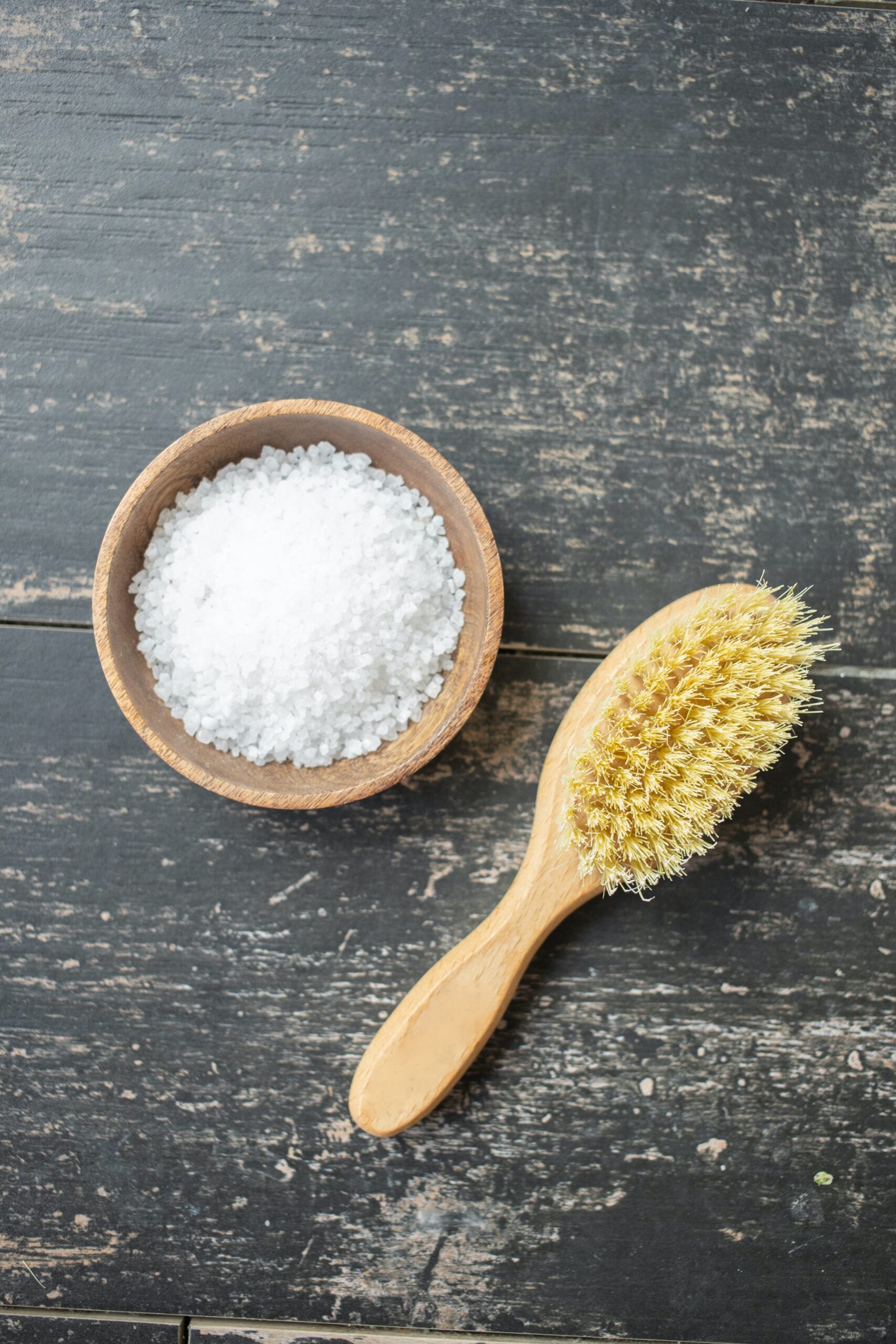
Fortunately, a popular and vital component of bath time can also be in use as a simple and effective remedy for removing stumps: Epsom salt, also known as magnesium sulfate, is a naturally occurring chemical.
Applying it to a stump in a high enough concentration, will pull the moisture out of the stump, eventually causing it to die.
Epsom salt is frequently in use to remove tree stumps because it hastens the breakdown of organic matter. When applied to a tree stump, Epsom salt has the ability to accelerate the rotting process by as much as seven years, depending on the size of the stump.
However, keep in mind that despite the fact that Epsom salt can be in use effectively to destroy tree roots and cause rot in tree trunks, it can also cause damage to the roots of neighboring plants, so you need to exercise extreme caution while using it. In any case, the following is a guide on eliminating a tree stump using Epsom salt.
Guide:
- Using a power drill and a large drill bit, make holes that are several inches deep and about an inch wide in the stump. Create holes into the stump at the maximum depth practicable, leaving approximately 1 inch between each hole.
- After the holes have been bored, fill them with the Epsom salt mixture. In order to achieve the greatest effects, apply a generous amount of salt. Using this all-natural strategy will prevent the roots from taking in water and nutrients.
- To facilitate the salt’s penetration into the stump, sprinkle some water on it beforehand. Try to limit the amount of water you use so that none of the salt is lost.
- After that, evenly distribute Epsom salt across the entire base. To finish, cover the stump with a tarp so that any precipitation that might fall on it won’t be able to wash any of your top-secret ingredients out of the holes.
- To secure the desired outcome, it is necessary to perform this procedure on a regular basis. Repeat the process if the color of the trunk has not changed significantly after applying the mixture for another week or so.
If successful, this approach will cause the stump to die within three months and completely decay in one year. Epsom salt is effective because it contains magnesium sulfate, which can be toxic if applied excessively. However, while putting Epsom salt on your stump, exercise caution because excessive salt will damage the plants nearby.
How To Kill A Tree Stump With Chemicals?
These should be applied to a newly removed tree stump to be effective. So, if your stump has been in place for some time, you may want to consider giving it a new cut. Furthermore, the fall and winter seasons are ideal for applying chemical killers, which are typically in use by brushing them onto the cut surface or pouring them into the drilled holes.
RELATED: Top 10 Weed Killers For Bermuda Grass | A Comprehensive Guide
However, it is essential to remember to strictly adhere to the precise directions provided on the packaging of the product you select.
The majority of these products contain systemic insecticides like triclopyr, which kills the roots and prevents new suckers from growing in their place. Some also have potassium nitrate.
This substance includes potassium, nitrogen, and oxygen, which shorten the time it takes for natural decay to as little as four to six weeks. In addition, it does not negatively affect the natural world, and it is the most efficient product now available.
So, what are some of the products that you can use to kill your tree stumps? In this article, I’ve tried to simplify your search by narrowing the field to four top-tier stump killers, one from each price range, and providing a detailed analysis of their relative merits and drawbacks. So, let’s go and take a look at them one by one:
1. Bonide Vine & Stump Killer
You can save time and money by using Bonide Vine & Stump Killer to prevent the regrowth of cut stumps.
Pros & Cons
| Pros | Cons |
| It contains granules that can be used right away.Deeply penetrates the roots of the stump. | Rots stumps that are older than 12 months old. Multiple applications are required for it to function. |
How To Use It?
Drill four holes into the tree stump, and then fill each of those holes with the mixture. Next, fill the holes with water and let them sit for a period of three months.
Also, due to the precise applicator, you won’t need to put in a lot of effort to apply the product to the stump, as it will reach all the way down to the bottom of the issue.
The fact that Bonide Stump Out can be in use for many purposes, including the elimination of vines and other types of woody plants, is one of the things I like best about this product.
Things To Keep In Mind
It is important to note that this product is intends an application to an old, seasoned tree stumps over 12 months of age to rot them. However, it is perfectly safe to use on freshly cut stumps as well in order to prevent them from resprouting. But, after a year, you may do a second application to the stump to hasten its decomposition.
This would include dissolving the cellulose layers of the stump and rendering the wood permeable. Aside from that, the applicator cap’s simple and sleek design landed it on our list of top picks. In addition, you need only pour the granules down into the cavities of the tree stumps, which will keep your hands clean.
You should also be aware of the fact that the majority of other stump killers are from potassium nitrate. However, the Bonide Stump Out is made with sodium metabisulfite, which is an inorganic preservative that fights bacteria.
2. Gordon’s Tree Stump Killer
Gordon’s Tree Stump Killer is a ready-to-use solution that decomposes stump roots and prevents regrowth.
Pros & Cons
| Pros | Cons |
| Extremely potent.Squirt bottle allows direct stump application.Suitable for immediate use. | It could be deadly to the plants and grass around it. |
How To Use It?
It’s as simple as pouring the formula into the hole. However, because of the product’s high concentration, it must be diluted with water in order to be used for a longer period of time.
Also, the fact that this stump killer is in a convenient spray bottle is, without a doubt, the best feature of the product. So, applying the liquid directly on the stump is not difficult.
You can also drill through the tree’s outer layer to send the product deeper into the core.
Things To Keep In Mind
A ready-to-use solution, Gordon’s Tree Stump Killer is a formula that rots a stump all the way down into its roots while preventing any new growth from occurring.
Mix it with a brush killer, then apply it within the drill holes.
You also have more than enough product in the bottle, which contains 32 ounces, to make multiple applications or to eliminate several stumps.
3. Spectracide HG-66420 Stump Remover
Spectracide Stump Remover is a stump killer that speeds up the decaying process and leaves the stump porous.
Pros & Cons
| Pros | Cons |
| Highest Quality at the Lowest Price.It won’t kill the plants around it. | Decomposition requires a little more time.Those with bigger trees should look elsewhere. |
How To Use It?
After you have drilled the holes in your stump using the appropriate tool, you can then pour the solution in. To make the granules easier to dissolve, you can use hot water to split them up into smaller pieces.
In addition, before applying the granules to freshly cut stumps, you should first apply a brush killer to the area. The 16-ounce product is effective on stumps that are either small or medium in size and are totally dry.
The simple pour nozzle is a helpful tool that allows the formula to be poured smoothly and precisely into the drill holes without requiring much effort. After that, the tree stump will rot and die thanks to the active component potassium nitrate.
Things To Keep In Mind
Spectracide Stump Remover is a stump killer that won’t break the bank and performs precisely what it states it will do on the bottle. In addition, the easy-to-apply Spectracide Stump Remover gets right to the source of the problem and speeds up the decomposition process.
This chemical stump killer comes in the form of granules, and the amount of time it takes for the breakdown process to finish can range anywhere from a few weeks to several months, depending on the size of the tree stump.
4. Roundup Tree Stump And Root Killer
Stump, tree, bramble, nettle, and other deep-rooted and woody plants are no match for Roundup Stump Killer.
Pros & Cons
| Pros | Cons |
| Kills other weeds, particularly deep-rooted perennials.Affordable. One 250-liter bottle kills 16 tree stumps! | No notable drawbacks |
How To Use It?
Mix one cup of the liquid pesticide with nine cups of water in a mixing bowl. After diluting the concentrate, it is ready to spray over the newly cut stump.
The mixture will swiftly spread into the roots, inhibiting their ability to regenerate and ultimately kill the plant. The formula works quickly, and depending on how big the tree stump is, the dying process should start in around two to four weeks.
Things To Keep In Mind
Even someone who has never used Roundup before won’t have any trouble cutting down a tree with it. Through its systemic action, this non-selective herbicide is able to damage the tree’s trunk roots.
You can also use this product to kill other difficult and tenacious weeds around the garden, such as Japanese Knotweed and Ivy. Both of these weeds are notoriously difficult to eliminate under normal circumstances.
Tips For Killing A Stump Using Chemicals
To aid the chemicals in killing tree stumps, remove as much of it as possible using a chainsaw.
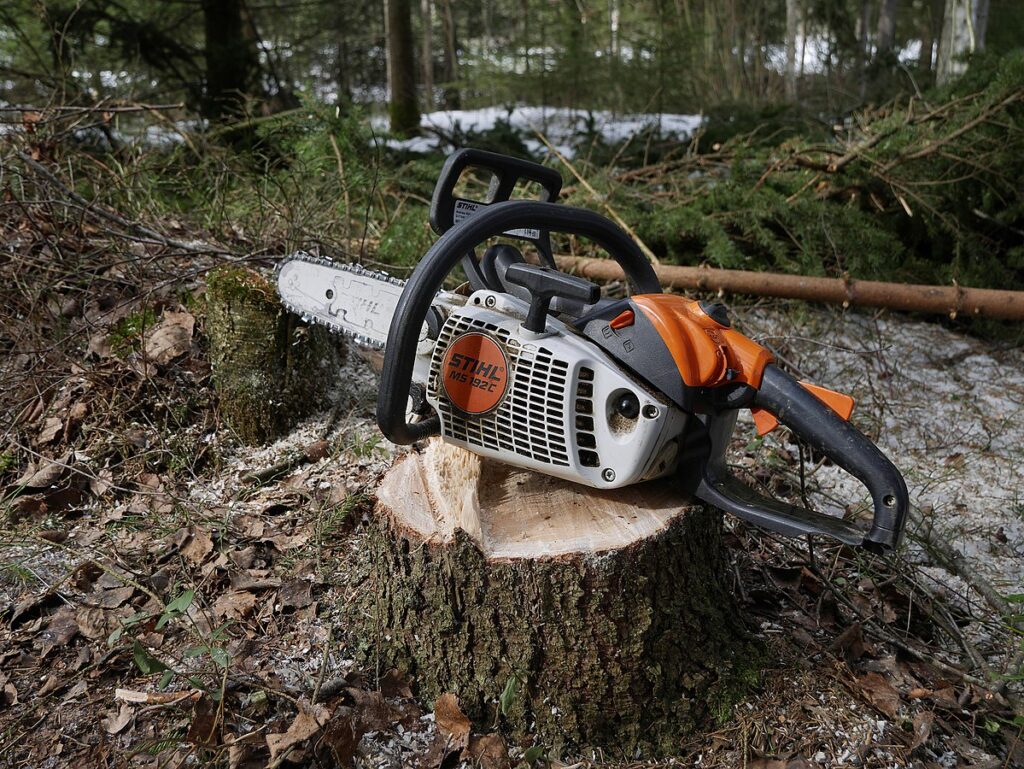
The use of chemical tree stump killers is typically the approach that is the slowest (although not as slow as specific natural alternatives, which is a point earlier). Still, it is also the method that requires the least amount of manual labor and is the cleanest technique.
As a result, it should not come as a surprise that this method is also the most widely in use DIY strategy. That is why we are here with some tips to help you out.
Keep An Eye On Your Stump
Maintain regular checks on the decomposition process of your tree stump and, if required, apply additional stump killer chemicals. After some time has elapsed, the consistency of your stump should change to become more sponge-like. At this point, one can dig it out or remove it using a pickax.
Follow The Manufacturer’s Guidelines
If the stump killer you’re using is granular, the manufacturer will probably suggest adding water to the drill holes so that the granules may dissolve and soak into the wood fibers of the stump. This will allow the stump killer to work more effectively.
Safety Is A Must
Fill each drill hole with the chemical stump killer you have chosen while wearing your protective goggles and gloves. Once again, before using, make sure to read and follow all of the instructions on the bottle provided by the manufacturer.
Drill Holes In The Stump
You must drill vertical holes ranging from half an inch to one inch in diameter into the remaining portion of the stump in order to expose the stump as much as possible.
Drill the holes at a distance of one to two inches apart, then drill them as deeply as you can up to a depth of six inches. Your goal should be to drill deep into the trunk of the tree, just below the surface of the ground that is surrounding it.
Use Physical Removal Alongside
You should get rid of as much of the stump as you can by cutting as low to the ground as you can using a chainsaw or another saw of good quality. However, when you are working on this task, it is imperative that you use protective eyewear and gloves.
Furthermore, it would also help if you remove the tree’s bark because it acts as a kind of waterproofing and can slow down the decomposition process.
How To Speed Up The Process Of Stump Rot?
Increasing soil aeration near tree roots speeds stump rot.
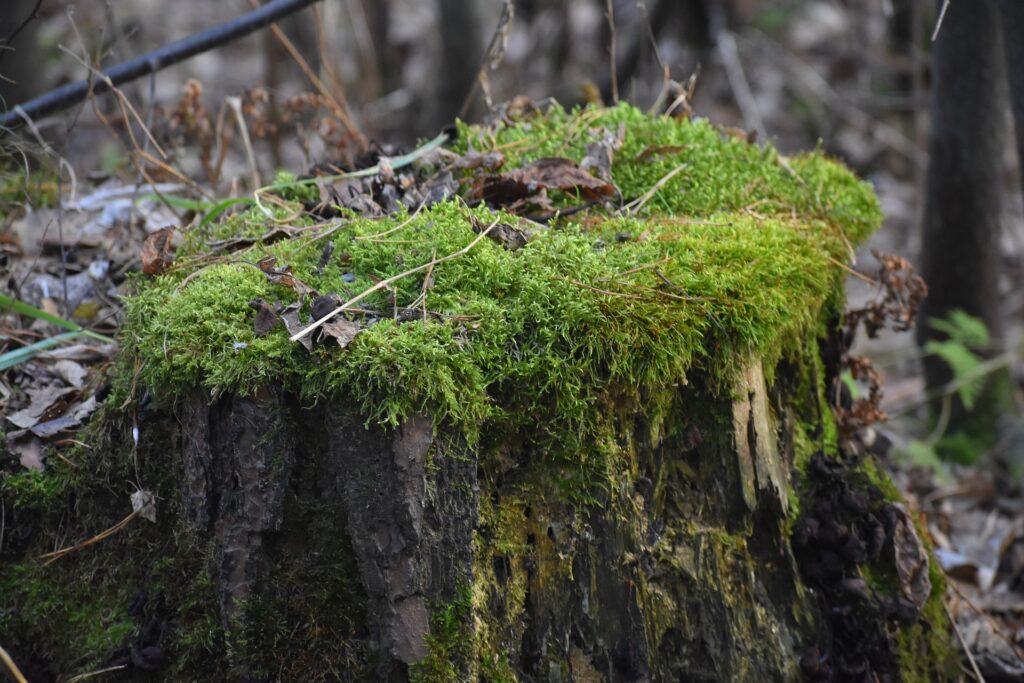
A variety of different elements determines the rate at which your tree stump will decompose, some of which you won’t have any control over. For instance, the stump of a hardwood tree will take far longer to decompose than the stump of a softwood tree.
However, you can hasten the process of stump rot by taking some additional aggressive activities. Temperature and humidity of the surrounding air will also be important factors in the development of an optimal environment for the decay of wood.
You are probably already familiar with the process of moist wood rotting and becoming softer; well, the same rules apply to stump rot.
Because decomposition requires oxygen, the rate at which it occurs is influenced by factors such as the makeup of the soil and the degree to which it is compacted. Therefore, the deterioration of the tree’s roots and stump will proceed more quickly and efficiently if the soil surrounding them is well-aerated.
Preparation
The most significant step, which brings us to our final point, is the preparation of the stump. The scientific research makes it abundantly evident that the ideal circumstances for rotting are substantial surface areas of damp wood that have enough ventilation. The question now is, how can you bring about these conditions?
- To the best of your ability, break up the soil around the tree roots and the tree stump in order to increase the amount of oxygen in the soil.
- During the rotting process, you should water the stump, its linked roots, as well as the soil in the surrounding area once per week.
- Increase the surface area of the wood by increasing the depth of the grooves you form by sawing, slicing, or hacking the surface of the wood. Also, take off the bark, then use an ax or a shovel to pry apart any roots close to the stump’s surface. Reduce the height of the stump to the ground as much as you can. Therefore, make sure that you reveal as much of the surface area as you possibly can.
Things To Avoid When Killing A Tree Stump
Weed killer does not intend to kill tree stumps and should only be in use for its original purpose.
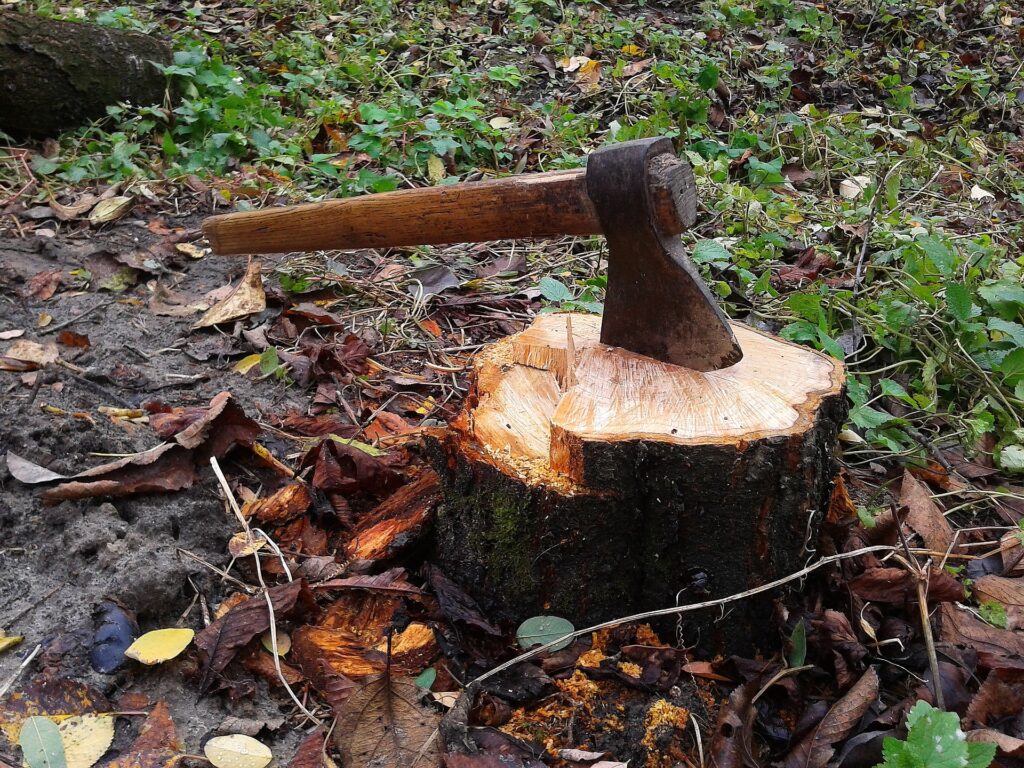
When removing tree stumps or killing them, there are a few things to keep in mind to ensure that the job is effective and safe. In this regard, there are also some things that you should avoid, some of which are described in the section below.
Do Not Use Diesel
Since diesel does not spontaneously combust like gasoline, it is in use for stump burning. However, as mentioned in that part of the article, including flammable liquid in the operation will not produce the slow and consistent burn necessary to kill the stump. However, it is quite possible that it might be effective as a chemical stump killer.
But if you need to buy a specific can and a quantity of diesel fuel but you don’t have any purpose for diesel fuel, wouldn’t it make more sense to use a chemical stump killer instead?
Do Not Use Motor Oil
There is no valid reason to try to eliminate tree stumps with motor oil rather than with any of the products that were previously described.
In addition, the price of a quart of motor oil is roughly equivalent to that of a container of a chemical killers. Which are products that have been tried and tested specifically for this objective. In addition to that, chemical stump killers require less cleanup and get the job done more quickly.
Do Not Use Bleach
Bleach can be in use to kill a stump if one pours it over in large quantities; however, we advise against using this approach because it might be harmful to the nearby plants. Instead, we advocate using another option. Additionally, bleach is not approved for use as a herbicide; thus, it must not be applied to plants under any circumstances.
Likewise, the risks are significantly greater than the potential advantages. Consequently, it would be much better for your yard’s ecosystem to adopt a more natural method, such as Epsom salt, because this can be helpful to both the plants and the soil.
Final Thoughts
If it is allowed to deteriorate naturally, the death and decay of a huge tree stump could take decades. In the meantime, it may generate a number of problems, such as ugly sucking, trip hazards, sinkholes, and even more issues.
So, if you have a tree stump on your property and want to remove it from your yard, use one of the ways listed above.
Although we encourage you to try your hand at some of the do-it-yourself ways if you have plenty of time on your hands, the quickest way to get rid of the stump is to either rent a machine or hire a professional who specializes in the task.
Frequently Asked Questions (FAQs)
What is the fastest way to kill a tree stump?
The quickest method for removing and eliminating tree stumps is using a “stump grinder” to grind the stump until there is nothing left.
It requires either employing the services of a tree removal expert or renting a stump grinder machine in order to cut up the timber of a tree’s trunk and roots.
How do you kill a tree stump naturally?
Epsom salt is a low-cost, all-natural solution for eliminating tree stumps, and it’s also potentially the least labor-intensive of all the available options.
However, it requires a fair amount of time. Nevertheless, if you have the time and the patience, you can get rid of a tree stump the natural way by using rock salt, Epsom salt, or boiling water.
How long does it take for Epsom salt to kill a tree stump?
Epsom salts can be used to eradicate tree stumps by drying out the roots as well as the residual trunk stump. This is a common do-it-yourself approach for destroying tree trunks, and it accelerates the decomposition process to take place within six to twelve months. In contrast, natural rotting can take anywhere from three to seven years.
Will bleach kill a tree stump?
Bleach is ineffective as a stump killer since it does not enter the tree’s system and kills the underground roots. So, even if it successfully sterilizes the chopped stump, it won’t do anything to stop new shoots from emerging through the ground from the roots of the tree and won’t kill a tree stump.
Does salt kill tree roots?
Rock salt can be an efficient method for killing tree roots by depriving them of water; however, this method is more time-consuming than using chemical herbicides.
However, the use of salt is not only economical but also an efficient method for speeding up the decaying process of the stump.
Sources for Further Reading
Removing Tree Stumps. The University of Illinois at Urbana-Champaign. (2014). Retrieved 27 October 2022, from https://extension.illinois.edu/blogs/rhonda-ferrees-ilriverhort/2014-06-20-removing-tree-stumps#:~:text=A%20hot%20fire%20is%20required,but%20it%20is%20hard%20work.
How to Remove a Stump. South Dakota State University. (2022). Retrieved 27 October 2022, from https://extension.sdstate.edu/how-remove-stump
Editor’s Recommendations
We hope you learned something from this article, please do read our other articles too:
Lawn Tractor Vs. Zero-Turn | Which Is Best & Which Should You Choose?
Milorganite Vs. Scotts | Which Is Best and Which Should You Use?
Spike Vs. Plug Aerator | Which Is The Best & Which You Should Use?







